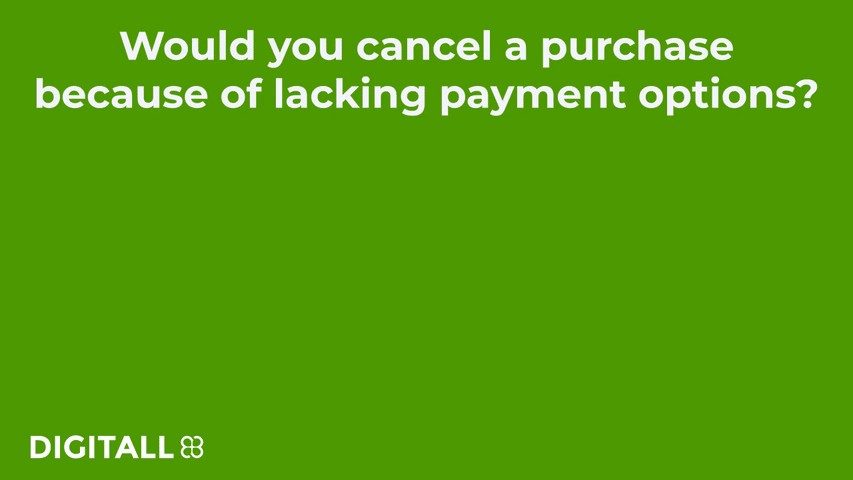2 min read
Why Customer Experience Is Becoming the Ultimate Competitive Edge
Products can be replaced, prices can be compared, but experiences last. In the chapter “Customer...
By Juliane Waack on 31.08.2022

5 min read
Two out of three online customers "abandon" their digital shopping carts. Often enough, payment issues hinder customers from making a purchase. Here's, what you can do about it.
Content:
According to studies by the Baymard Institute, almost every second customer abandons their shopping cart due to additional costs they deem too high, such as shipping, taxes or other fees.
Of course, cutting costs is not really the most economical solution to retain customers, for many vendors, it is not possible to simply cut shipping and tax costs can't really be circumvented.
However, transparency is key when it comes to any additional costs. Often, customers only get to see the full price at the checkout - but at this point, these "surprises" can decrease any purchase willingness. If possible, you should show all costs right on the product/service page.
By the way, free shipping is one of the biggest purchase incentives for most customers which is why it is worth to calculate whether the increase in customers could potentially "pay" for the free shipping offers.
Another way to soften shipping costs is to set a minimum order sum at which delivery will be free and to show/communicate this sum clearly on all shopping pages. This also can be an incentive for customers to spend more than they intended.
One out of four customers will leave a shopping page if they have to create an account to purchase something. Forcing customers to create an account is a clear example of the company-centric view that ignores the customer-view (read more about this here). Of course, an account is attractive to gain customer data and be able to communicate with customers.
However, it is inconvenient for customers, especially if they purchase something for the first time and don't want to commit to a brand just yet.
Guest accounts offer fast payment without much hassle. And if you still want your customers to register properly, give them attractive incentives, such as discounts, free shipping or other attractive bonuses as part of a loyalty program.
According to our own surveys, two out of three customers will cancel a purchase if their preferred payment option is not being offered. Only 4% would never cancel and 29% need a pretty amazing product or service to continue their journey.

It is crucial to ask customers how they want to pay and offer these options.
As Stripe found out in their study on European customer behavior, the localization of payment methods is important for international players since customer groups have different preferences. For example, German customers are quite old-fashioned and still love to pay via debit. Polish customers love their bank transfers and in the Netherlands, a whopping 95% of all surveyed customers pay with the online payment method iDEAL.
By the way, as Stripe points out, using localized payment options can also save big sums due to lower transaction fees and even sales taxes. It's therefore worth it for numerous reasons to take a closer look at different markets.
Companies will create dazzling marketing campaigns, design their online shops as colorful, exciting environments to lose yourself in and then have the most convoluted, complicated, and buggy payment process imaginable. According to the Stripe study, 97% of leading German eCommerce companies make at least five mistakes on their payment processes, from bad formatting, lack of payment options up to actual errors and insufficient error messages.
Imagine you have the greatest shop in the world and customers line up to buy your products but then they have to make it through a labyrinth, solve a logic puzzle and leave all their information to a stranger before they can pay and leave the store. That's how many current payment journeys look like today.
Transactional emails, process steps and -pages tend to get overlooked when it comes to the overall look & feel of your customer experiences. In fact, according to a study by SparkPost (via MediaPost), 42% of surveyed companies let developers and IT personnel write the texts for transactional emails and IT processes instead of collaborating with their marketing teams.
However, these touchpoints are some of the most important because they usually cover important steps on the customer journey. All your interactions with your customers - this includes payment processes, forms, billing emails and even the billing document - should keep in line with your overall brand, including the visuals and messages.
For example, if your brand communicates in a fun humorous way with your customers, keep this up for your payment processes, so there is no disconnect between the beginning of the shopping experience and the checkout.
Find out how to optimize your eCommerce presence with the right technology and best practices to create customer-centric journeys and increase loyalty.
Stream our DIGITALL Thoughts Episode on Commerce and hear all about personalization, payment, subscription services and other commerce trends from our experts.
Juliane Waack is Editor in Chief at DIGITALL and writes about the digital transformation, megatrends and why a healthy culture is essential for a successful business.
by Sabine Kirchem
Products can be replaced, prices can be compared, but experiences last. In the chapter “Customer...
by Sabine Kirchem
Customer Relationship Management (CRM) is no longer just a technical discipline but revolves around...
by Sabine Kirchem
There's loads of data out there – but are we truly utilizing it? And more importantly, are we using...